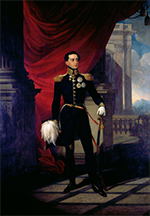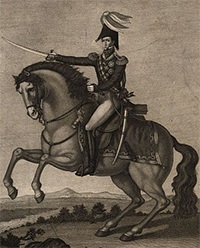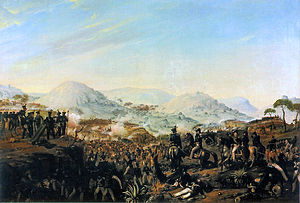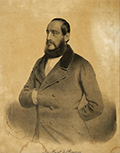King Miguel I of Portugal
Miguel I was King of Portugal for six years during the 19th Century. He seized the throne in anger and gave it up in defeat, spending the rest of his life in exile. 
He was born on Oct. 26, 1802, in Lisbon. His mother was Carlota of Spain, and his father was the eventual King John VI, who at that time was regent for the reigning monarch, Maria I. Miguel's older brother, Pedro, was the heir to the throne. Miguel was 5 when the royal family fled Portugal, in the wake of a Franco-Spanish invasion, for the safety of faraway Brazil, Portugal's largest colony. Miguel grew up in Brazil, returning in 1821 with his mother and father, as John VI retook the throne after agreeing to be a constitutional monarch, in line with the country's first constitution. At that time, Pedro stayed behind, as ruler of Brazil. 
Miguel was very much a fan of absolute monarchy and wanted it returned to his country. He supported an 1823 counter-revolution known as the Vilafrancada, gaining some powerful friends and supporters but ultimately failing in his attempt. Despite his actions, his father named his commander of the army. The following year, Miguel was involved in another intrigue, the Abrilada, in which he rounded up a number of government ministers and placed the king under house arrest, all under the pretense of stopping a conspiracy against the government. John had enough power and influence still to dismiss Miguel as army commander; he then sent his recalcitrant son to exile in Vienna. John VI died on March 10, 1826. Pedro was John's oldest living son and was technically the heir to the Portuguese throne. However, John had appointed his granddaughter Maria, Pedro's daughter, to succeed him. Lurking as well in the succession mix was John's second-oldest son, Miguel, who had led more than one uprising against his father and had gotten himself exiled to Austria. The people of Portugal made it clear that they did not want a monarch again ruling over both Brazil and Portugal and so Pedro agreed to take the throne but then give it up. John VI died on March 10, 1826, and Pedro became King of Portugal on that day. He abdicated on May 2 of that same year, and his sister became Queen Maria II. John's grand plan had Maria and Miguel eventually marrying and ruling together. While Maria was in Vienna to pursue an education, Miguel seized the throne, declaring himself king on June 23, 1828. Maria ended up with France, where she was reunited with her father and stayed with the French king, Louis Philippe. 
Pedro marshaled support (including one of France's national heroes and a strong friend of the cause of American independence, the Marquis de Lafayette) for Maria's return to the throne and led an army in an invasion of Portugal in July 1832. Pedro's troops, supported by troops from the U.K., landed in Porto and took the city unopposed. Miguel's troops took up siege positions around the city's perimeter. After a year of stalemate, Pedro authorized a risky mission to to the Algarve; it was successful, and his forces drove onward, taking Lisbon on July 24, 1833. At this point, a struggle in Spain spilled over the border. Isabella II who was defending her throne in the first of three Carlist Wars against her uncle, Don Carlos, who was also Pedro's uncle. The erstwhile Brazilian emperor threw in his lot with his cousin, not his uncle, and thereby gained an ally in the Spanish forces loyal to Isabella II. The result was a victory for Isabella and Maria. 
Miguel abdicated on May 26, 1834, and Maria retook the throne. Later that year, the Cortes sent Miguel and all of his descendants into exile. Four years later, another pronouncement removed from Miguel and anyone in his line of descent any chance of succeeding to the throne legitimately. Miguel never returned to his homeland, living in Italy and the United Kingdom and then Germany. In 1851, he married Princess Adelaide of Löwenstein-Wertheim-Rosenberg. They lived in Bronnbach, in the Grand Duchy of Baden, and had seven children together, all of whom survived into adulthood: Maria des Neves (1852), Miguel (1853), Maria Theresa (1855), Maria Josepha (1857), Adelgundes (1858), Marie Anne (1861), and Maria Antónia (1862). Miguel I died on Nov. 14, 1866, on a hunting trip.
|
|
Social Studies for Kids
copyright 2002–2025
David White




